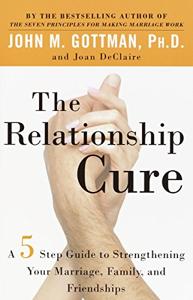
Want to learn the ideas in The Relationship Cure better than ever? Read the world’s #1 book summary of The Relationship Cure by John Gottman here.
Read a brief 1-Page Summary or watch video summaries curated by our expert team. Note: this book guide is not affiliated with or endorsed by the publisher or author, and we always encourage you to purchase and read the full book.
Video Summaries of The Relationship Cure
We’ve scoured the Internet for the very best videos on The Relationship Cure, from high-quality videos summaries to interviews or commentary by John Gottman.
1-Page Summary of The Relationship Cure
Overview
Relationships are extremely important. They have the power to change people’s lives and inspire them to do great things. However, relationships vary greatly in terms of their dynamics, personalities, and situations. So how can we generalize about all types of relationships? The answer is that there isn’t a one-size-fits-all solution for every relationship problem. Even if there were such a thing as a cure for all problems with relationships, it would be impossible to apply it because each type of relationship has its own set of problems.
There are no magic pills that will fix your relationships, but there are some general strategies you can learn to help you deal with them better. The strategy depends on the relationship and issue at hand, but the principles remain the same. These principles come from research done by experts and ideas presented in this book.
In this article, you’ll learn how to understand the hidden messages behind everyday communication. You’ll also learn about a place called “The Love Lab,” which was built by one of the authors after conducting research on relationships.
Big Idea #1: People don’t form close relationships by simply “opening up” to each other.
What’s the secret to having a happy, healthy relationship? It might be that you’re willing to share your deepest thoughts and feelings with another person. However, some psychologists are now saying otherwise after conducting research into this matter.
The main message in this passage is that people don’t make friends by opening up to each other. In 1990, John Gottman and his team at the University of Washington set up a unique research center called “the Love Lab.” Couples were invited to spend a weekend there living their lives normally. The only instruction given was for them to live as they would outside the lab.
The study was conducted in a laboratory where couples were observed for 12 hours a day. The apartment had four surveillance cameras and two-way mirrors to observe them. They were also wired with microphones and body sensors that monitored their stress levels, including heart rate and sweat.
Dr. Gottman spent lots of time studying couples on video to see what they talked about and how they interacted with one another. He found that most of the conversations were not very personal, but rather superficial in nature.
“Honey, could you get me a cup of coffee?” “Sure.” Or: “Hey, check out this comic strip!” “Shh! I’m trying to read.” These are pretty common interactions. However, Dr. Gottman thought the experiment was a waste of time until he reviewed the footage for months and found that there is something critical to forming close relationships in these mundane conversations.
It’s not important what people talk about, but how they talk to each other. This is true in all relationships.
Big Idea #2: Bids are the most fundamental units of emotional communication.
A simple request for a cup of coffee from your spouse might not seem like a big deal, but imagine if they responded by telling you to get it yourself.
In the first scenario, a woman is telling her husband that she’s pregnant. In the second, a man is telling his wife he wants to divorce her.
The authors call this “making a bid” and the way your partner responds to it.
The key message is that bids are the fundamental units of emotional communication. These can be questions, exclamations, gestures or facial expressions. They’re any attempts to establish an emotional connection with someone through verbal or nonverbal communication.
Bids are a way to connect with people. They can be verbal, nonverbal or written. The person receiving the bid has three ways of responding: turning toward it, turning away from it or rejecting it outright.





